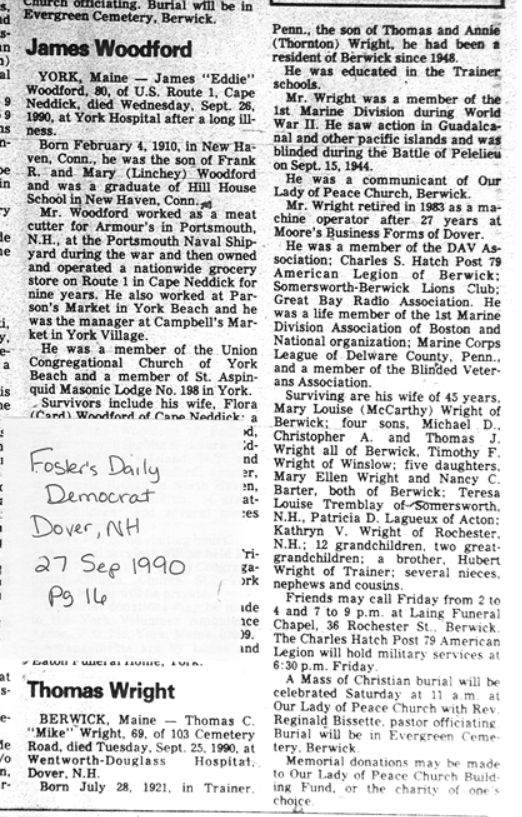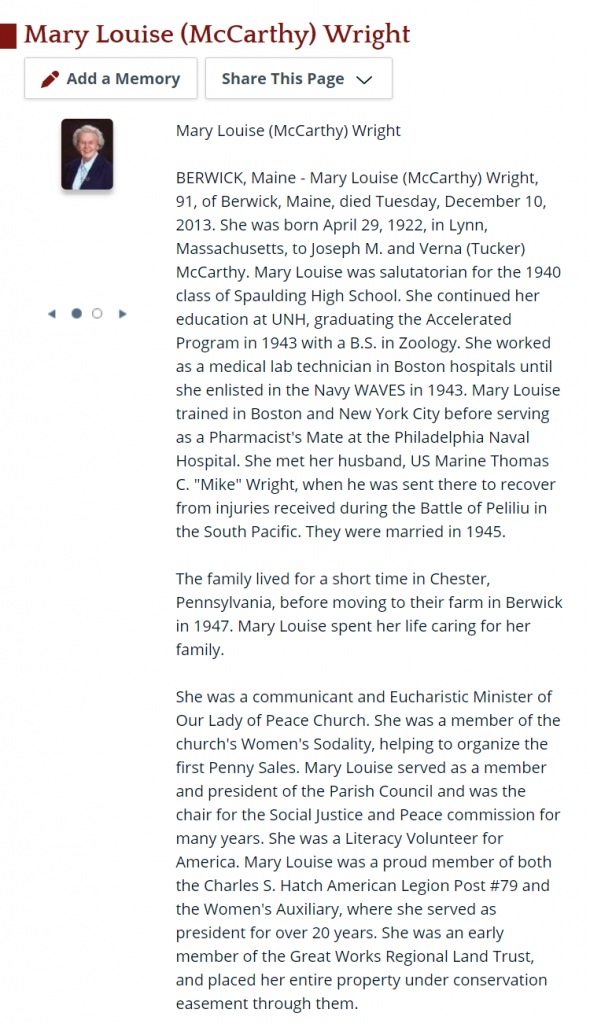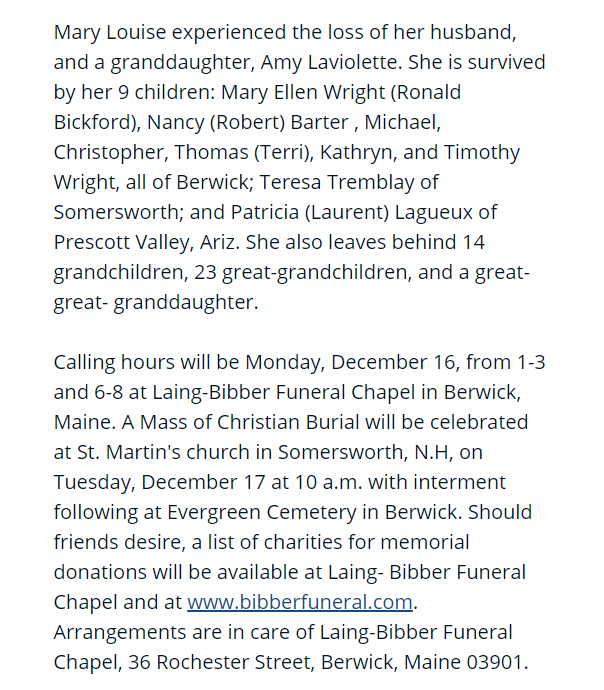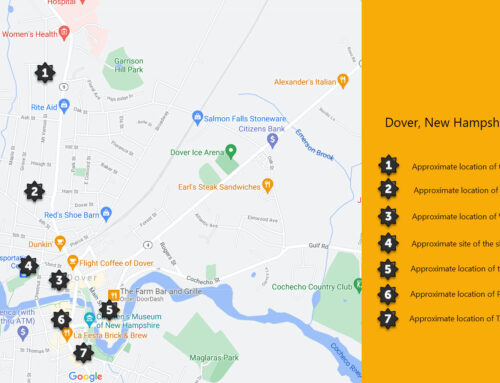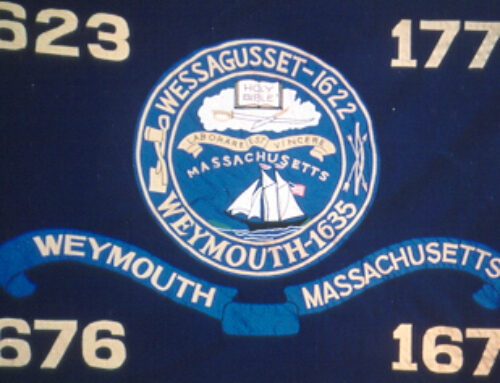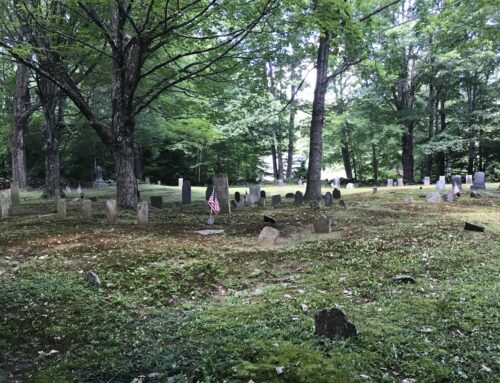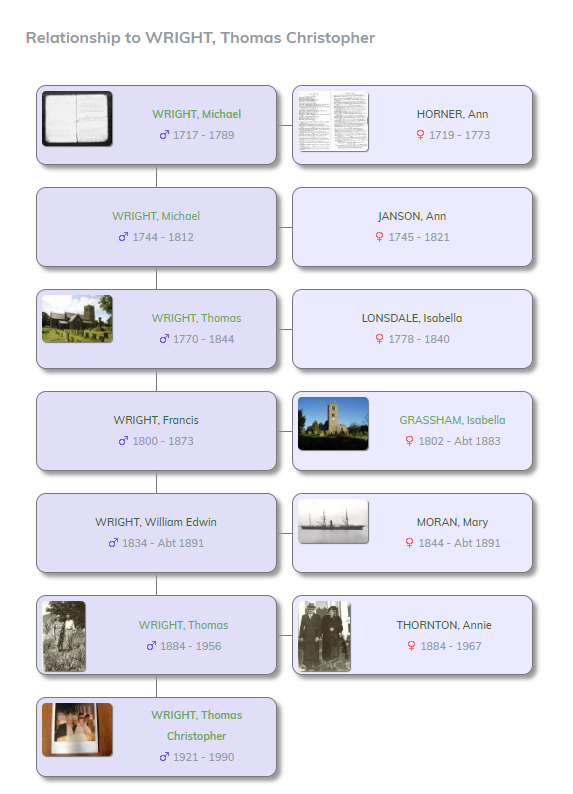
Generation 7: Michael Wright (1717-1789) and Ann Horner (1720-1773)
Jump to Generation: 7 | 6 | 5 | 4 | 3 | 2 | 1
Our first Wright ancestors that I can write about confidently are Michael Wright (1717-1789) and Ann Horner (1720-1773).
Michael was born in 1717 and christened on 9 Feb 1717 in Kirby-Wiske, Yorkshire, England, the son of Thomas Wright and Dorothy Jackson (I know his parent’s names, I’m not exactly sure of their identities quite yet. If you are reading this and can help me, please reach out.).

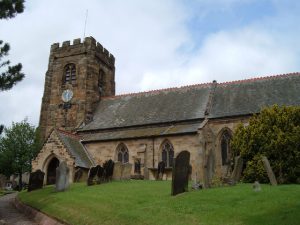
St John the Baptist’s Church where Michael Wright was baptized in 1717. https://commons.wikimedia.org/w/index.php?curid=3990245
Kirby Wiske is an English village in North Yorkshire. Michael was baptized in the Anglican parish church in the village, St John the Baptist’s Church which dates back to the 12th century.
On 13 Sep 1741, when he was 24, Michael married Ann Horner in Pickhill with Roxby, just a few miles away from the village in which he was born.

I believe that Ann was baptized 3 Jan 1719 in Guiseley, Yorkshire, England, the daughter of John Horner and Ann Wadkinson who had themselves married in Guiseley on 26 Nov 1716. Guiseley is approximately 75 miles from Pickhill. This is considered a short distance today, but was quite far in the 18th century. As of yet, I have no explanation as to how Michael and Ann may have met.


St. Oswald’s Church in Guisely where Ann Horner was baptized in 1719. Photo by Stanley Walker, CC BY-SA 2.0, https://commons.wikimedia.org/w/index.php?curid=12935170
Ann was baptized in St. Oswald’s Church in Guisely. The church dates back to the late 11th or early 12th century.
A POSSIBILITY: Guisely is a borough of the city of Leeds and the population of Leeds was growing in the 18th century. In the late 17th century, travel writer Celia Fiennes wrote that Leeds was a large town with wide, well-tended streets and houses built of stone . Just a few decades later, in the 1740s, when Michael and Ann married, wool manufacture was the primary industry in the city, and there were also many other trades there. Perhaps Michael had gone to work in the city as a young man, met Ann, and brought her back to his more rural home to marry.
Michael and Ann had two sons, both born in Thornton Watlass, Yorkshire, the village where the next several generations of Michael and Ann’s family lived.

Screenshot from Wikipedia https://en.wikipedia.org/wiki/Thornton_Watlass. Contains Ordnance Survey data © Crown copyright and database right, CC BY-SA 3.0, https://commons.wikimedia.org/w/index.php?curid=11604719
I visited Thornton Watlass during a winter trip in 2017. It remains today as it has been described for centuries: a very small village (population of 240 in 2017) with stone houses circling a village green.
The Anglican Church of St Mary which dates back to the 11th century is just outside the village. Although I found a number of Wright gravestones in the churchyard, they mostly dated from the 19th century and the older headstones were destroyed or unreadable.
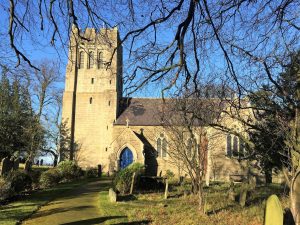
St. Mary’s church in Thornton Watlass. Photo taken during my 2017 trip. I found many Wright gravestones, but none I have identified in our family tree yet. Most of the stones were destroyed or unreadable.
Michael and Ann had two sons:
Michael Wright, 1744 – 1812 (our ancestor) and Thomas Wright, 1749-1783.
Ann died 13 Jul 1773 at the age of 54 in Thornton-Watlass. Her youngest son Thomas was only 10 years old at the time.
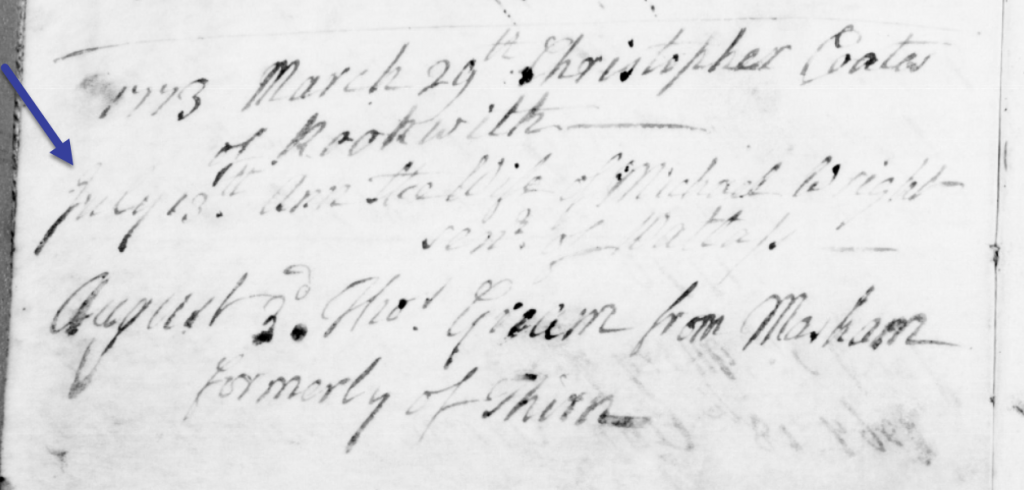
Michael outlived Ann by 16 years and died on 17 Feb 1789 at the age 72.
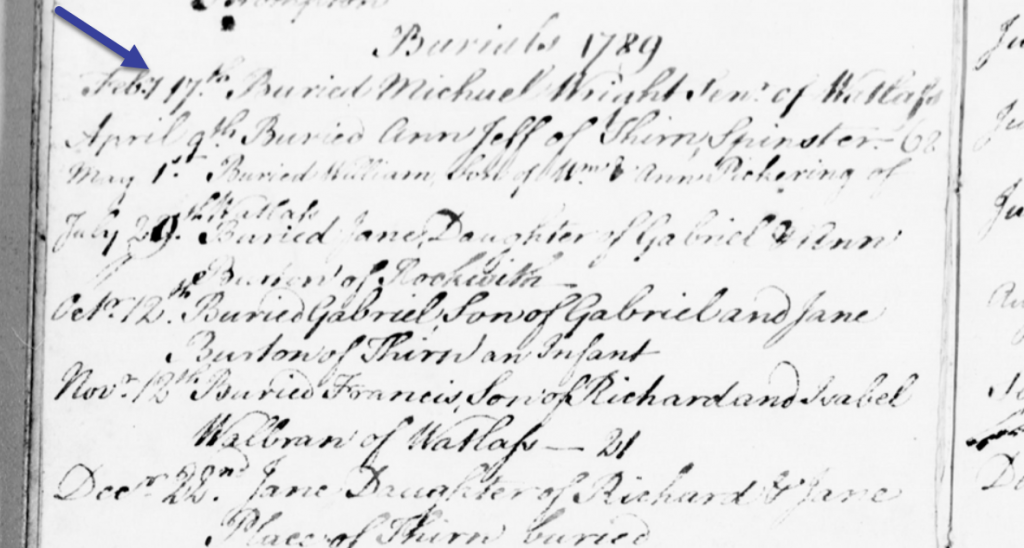
POSSIBLE GENERATION 8: Although I still lack evidence that gives me confidence, I believe that Thomas (Michael’s father), son of Thomas (Michael’s grandfather), was born 1 Sep 1690 in Thornton le Moor, Yorkshire. Thomas Wright and Dorothy Jackson married on 18 May 1712 in Hovingham, Yorkshire. According to a 1758 parish burial record, Thomas predeceased his wife and Dorothy was buried in Hovingham with him in 1758. But, confusingly, I found a burial record in the parish register for a Thomas Wright, labourer and his wife Dorothy, both buried on 22 May 1720. It is possible that Michael’s grandmother’s name was also Dorothy and she and her husband Thomas both died on the same day. I need to research this more and will update this post as I gather more information.
Generation 6: Michael Wright (1744-1812) and Ann Janson (1746-1821)
Jump to Generation: 7 | 6 | 5 | 4 | 3 | 2 | 1
Michael Wright was born in Thornton Watlass in 1744, the son of Michael Wright and Ann Horner.

From a transcript of the parish record, we know that Ann Janson was born in 1745, also in Thornton Watlass, the daughter of Francis Janson (1712-1794) and his wife Mary.
Michael and Ann were married in Nov 1767 in Thornton Watlass. Their marriage banns were published on 24 Nov 1767. A term that is unfamiliar in modern times, banns were the public announcement in the parish church of the intended marriage of a couple. Typically, the announcement of the marriage was read aloud on 3 successive Sundays at church. Then, the bride and groom would visit the church in the morning before noontime and be married.
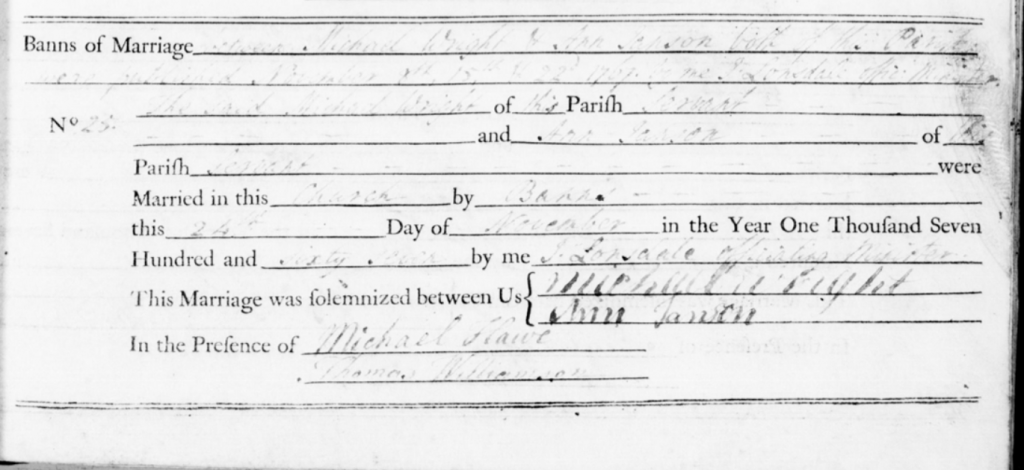
Although there is no way to know, it is likely that Michael was a farmer as were most of the Thornton Watlass residents of the time. He and Ann had 10 children together, 5 sons and 5 daughters:
Thomas (our ancestor), 1770-1884
Francis, 1772-1831
Michael, 1775-1834
John, 1777-?
Elizabeth, 1778-?
Mary, 1779-?
Miriam, 1781-?
Jane, 1784-1793
William, 1786-1868
Ann, 1790-1791
While it is hard to imagine how they were or were not impacted by national and international events while living in rural Northern Yorkshire, Michael and Ann lived through globally tumultuous times. Just some of those events that occurred during their life spans include:
- the Seven Year War between Britain and France beginning in 1756,
- the succession of George III to the throne in 1760,
- the American War of Independence from 1775-1781,
- the French Revolution in 1791,
- Britain declared war on France in 1793 which continued until the final defeat of Napoleon at the Battle of Waterloo in 1815,
- the formal Act of Union between Great Britain and Ireland forming the United Kingdom, and
- the abolition of the slave trade in 1807 followed by the freeing of all slaves in 1833.
Michael was buried on 4 Apr 1812 in the Thornton Watlass churchyard. He was 68 years old.

Ann lived 9 years after her husband’s passing and was buried in 1821 at the age of 77.
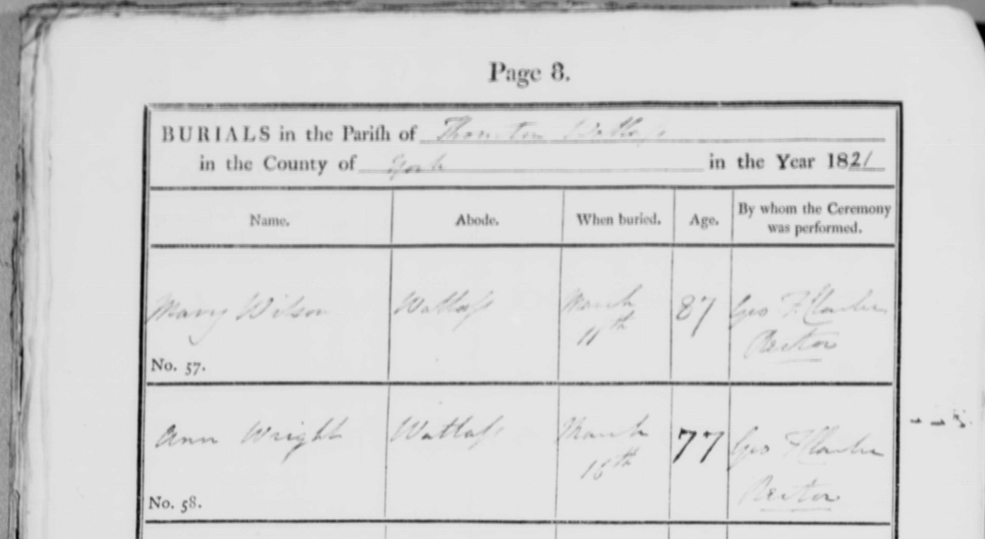
Generation 5: Thomas Wright (1770-1844) and Isabella Lonsdale (1778-1840)
Jump to Generation: 7 | 6 | 5 | 4 | 3 | 2 | 1
Thomas Wright was born 3 Aug 1770 in Thornton Watlass, the first of ten children born to Michael Wright and Ann Janson.
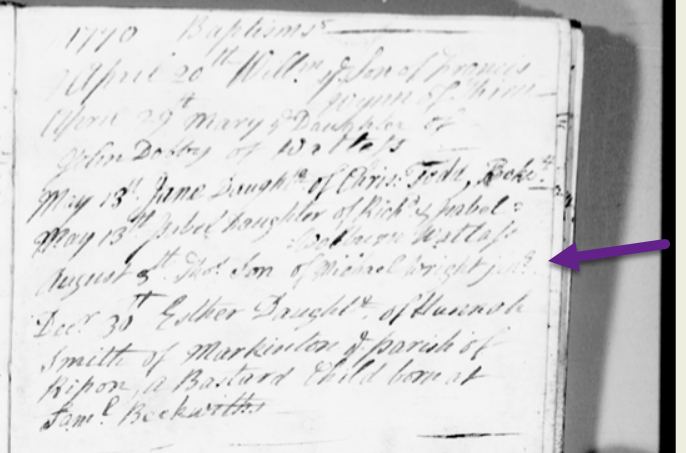
No birth record has been found for Isabella Lonsdale, although we know from her death record that she was born in 1778. At the time she married Thomas, on 20 May, 1799 at Ripon Cathedral in Ripon, Yorkshire, she was listed as living in Ripon.


Weddings in 18th century England were much the same as they are today with some differences in the details. The bride and groom would recite vows and the groom would give the bride a ring. Rather than rice, grains of wheat were scattered to represent fertility. Rather than throwing a bouquet, pieces of wedding cake were passed through the bride’s ring to feed the unmarried guests in hopes that they too would marry soon. Weddings were fun events where people would sing funny songs, dance, play practical jokes, and enjoy a meal together.
Together, Thomas and Isabella had 10 children; 5 sons and 5 daughters.
Francis Wright, 1800-1873 (our ancestor)
John Wright, 1802-?
Isabella Wright, 1805-?
Jane Wright, 1808-?
Thomas Wright, 1810-?
Joseph Wright, 1814-1815
Mariam Wright, 1816-1817
Dorothy Wright, 1818-1839
Ann Wright, 1820-1820
James Wright, 1821-?
At least 3 of these children died before reaching the age of 2. While more common than today, the loss of a child at this time in history was no less agonizing than it is today. Many children in the 18th and early 19th centuries died of childhood ailments such as measles, mumps, chicken pox, small pox, lead poisoning, thrush, tapeworms, and many other problems. The treatment for ailments was often just as bad or worse than the ailment itself. Treatments included bleeding, dosing the child with opium (poppy syrup), or giving them alcohol such as rum or brandy.
Thomas was probably a farmer, but was born when the Industrial Revolution (~1760-1830) was in full swing. At a time while many were moving away from farming to work in factories in the city, Thomas and Isabella remained in Thornton Watlass to raise their family.
Farmers often worked 6 days a week, and their entire families worked with them. Children were expected to work alongside their parents and were frequently put to work as young as 5 years. The industrial revolution brought changes to the industry of farming with innovations and inventions that changed the farming process. Farming was becoming easier in these days, but harder in others. There were less agricultural workers as more people moved to the cities for industrial work, crop output was generally increased but at the same time food prices were decreasing. Thomas would have had to find ways to cope with changes such as these.
Isabella died at the age of 62 in 1840 and was buried on 22 Apr.

In the 1841 Census, Thomas is living alone (age 70) in Thornton Watlass and is an agricultural laborer. His brother William and William’s family were living nearby.

Thomas died in 1844 when he was 74 and was buried on 20 Feb.

Unanswered questions: Who were Isabella Lonsdale’s parents? There was a Joseph Lonsdale and Dorothy Horner who were married in Ripon on 17 Aug 1766 who could have been her parents, although no evidence has been found. There is also a Francis Lonsdale and Rose Chepman who were married on 16 Feb 1779. Although this is a bit late given Isabella’s 1778 birth date, if these were her parents it could account for her missing birth record.
Generation 4: Francis Wright (1800-1873) and Isabella Grassham (1802-1883)
Jump to Generation: 7 | 6 | 5 | 4 | 3 | 2 | 1
Francis Wright was born in 17 Sep. 1800, the first-born child of Thomas Wright and Isabella Lonsdale of Thornton-Watlass, Yorkshire.
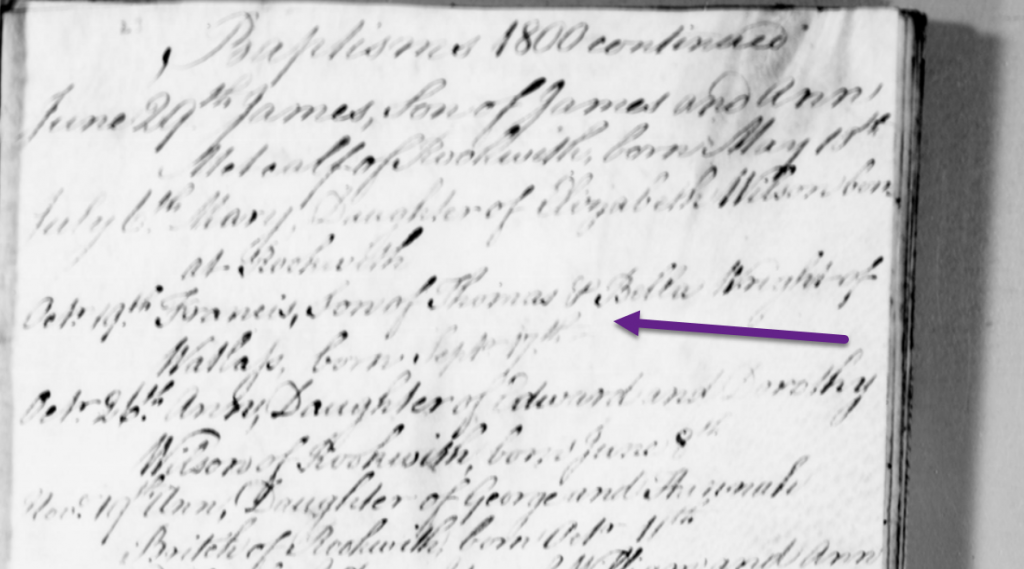
On 28 Jun 1823, Francis married Isabella Grassham in Bedale. Isabella was born in 1802, the daughter of Thomas Grassham of Hornby (1765-1831) and Ann Stoddart or Hoddard (1763-1859).
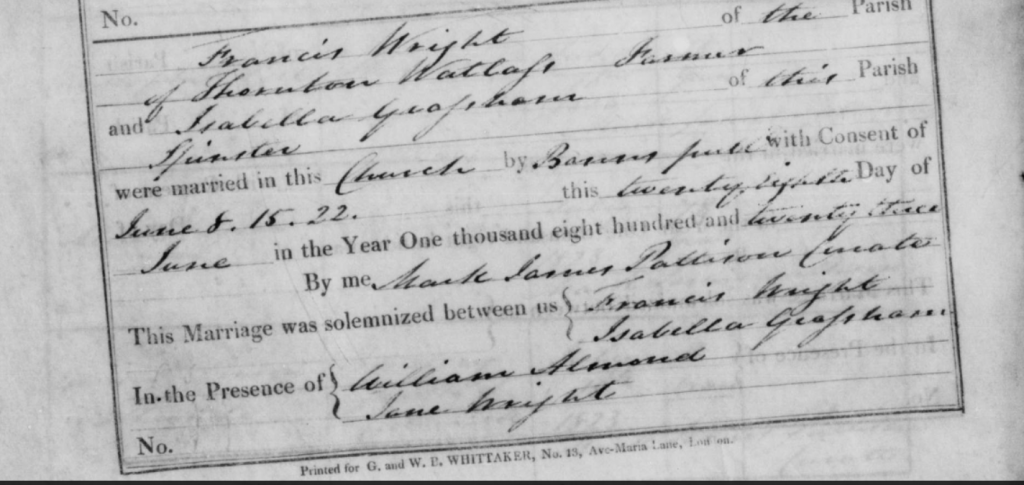
These are photos of Bedale Cathedral where Francis and Isabella were married, taken during my 2017 winter trip to Yorkshire, England.

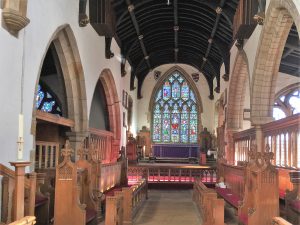

Francis and Isabella had 6 children together.
John Wright, 1830-1910
William Wright, 1834-1891 (our ancestor)
Ann Wright, 1838-1896
Isabella Wright, 1838-1918
Francis Wright, 1841-1922
James Wright, 1843-1924
By the late 1830s and early 1840s, England was in a recession as the markets developed during the Industrial Revolution began to slow. But, in the mid 1840s new innovations were developed, travel by locomotives, steamboats, and steamships were increasing, and new inventions such as the telegraph were introduced. This led to rapid economic growth from 1870 on.
It is in this environment that Francis and Isabella were the first generation of Wrights to move their family away from rural Thornton Watlass to the city. William was the first child to be born away from Thornton Watlass. He was born in Holbeck, just outside of Leeds, as were the next 3 children. Prior to 1851, Francis and Isabella moved again, from the Leeds area to the Bradford area.
In the 19th century, Bradford became known as the international center of textile manufacturing, particularly wool. At the epicenter of the Industrial Revolution, it quickly became the “wool capital of the world” and jobs for both children and adults were plentiful. In 1801 Bradford had a population of between 6000 and 13,000 (conflicting sources). By 1850, the population of Bradford was 182,000 and had gained a reputation as the most polluted town in England, with more than 200 factory chimneys churning black smoke day and night.
The life expectancy in Bradford at this time in history was just over 18 years old due to overcrowding and unsanitary living conditions, harsh work conditions, pollution, and frequent outbreaks of diseases such as cholera and typhoid. In 1848-49 for example, when Francis and his family were likely living in the city, 420 people died of a cholera outbreak. There were no sewers or drains in the city and the rapid population growth meant that housing had been constructed haphazardly and the dwellings of the working class have been described as “horrid.”
In the 1851 Census, we find Francis who is listed as a stone mason and journeyman living with his family in the township of Idle on a road named Pricking Fold, at the time a separate village, but today a suburb of Bradford.

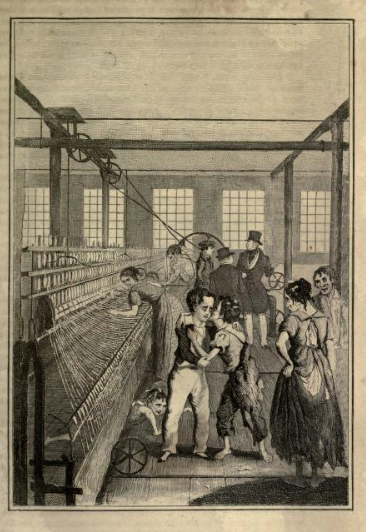
Illustration of piecers at work in the mills. Appeared in “The life and adventures of Michael Armstrong : the factory boy” by Francis Milton Trollope published in 1844.
Only James, who was 8 years old at the time was in school. All the rest are listed with professions, even Francis at 10 and Isabella at 13, both “piecers of worsted,” meaning that they were working in the wool mills. The job of piecers was to lean over the spinning machines and repair broken threads. By all accounts, piecing was demanding work requiring that the children run back and forth tending multiple spindles for 10 hours a day (a law was passed in 1847, limiting working hours to 10 per day for children and women—prior to that, many worked 12-14 hour days). Although it is hard to say how accurate it may be, one account from a factory reformer of the times stated that the piecers may have run back and forth totaling more than 20 miles each day.
Ten years later, in 1861, the family was still in the same home. Only Isabella, Francis, and James were still living at home and all were working either in the mills or as stone masons.
In 1871, when Francis was 71 years old, he was still working as a stone mason. Isabella (his daughter) was still living with him and working in the wool mill along with a granddaughter Martha who was also working in the wool mill at the age of 11.

Francis died shortly after this census, on 23 Mar 1873 at the age of 73.

Isabella lived for another decade. In the 1881 Census she was living with her daughter Ann and Ann’s family. They were living at 2 Pinnel Street in Idle. Unfortunately, this street doesn’t seem to exist anymore and I have as yet been able to locate where it was.

Isabella died on 10 Mar 1883 at the age of 79.

Generation 3: William E Wright (1834-1891) and Mary Moran (1844-1891)
Jump to Generation: 7 | 6 | 5 | 4 | 3 | 2 | 1
William Edwin Wright was born on 25 May 1834 in Holbeck, Yorkshire which is today a suburb of Leeds, the son of Francis Wright and Isabella Grassham. It appears that he spent at least the first 10 years of his life here. In 1851, when William was 18, we find him living with his family just outside Bradford in the village of Idle. By this time, he was working as a stone mason along with his father and older brother John.
Our next record of William is when he was 29 on 23 Nov 1865 and married Mary Moran who was 22 at the time. William was living on Tetley Street in Bradford and Mary was living at 25 Kent Street in Horton.
Of interest is the fact that William is listed as a widow on the certified copy of their marriage which I have obtained. I have not found any marriage record or any other information about William’s first wife.

Mary Moran was born, I believe in 1844, probably in County Sligo, Ireland, the daughter of a Thomas Moran and Maggie Clarke. I am still researching Mary’s exact ancestry, but have recently been aided by what appears to be strong DNA connections that have led me to a man I believe is her brother William (1834-1921). According to the marriage certificate, Mary’s father Thomas was already deceased in 1865. Her marriage was witnessed by a Catherine Moran who may have been a sister or more likely her sister-in-law as William had married a Catherine Kenny in 1862.
William Wright was able to sign his name on his marriage certificate but Mary was not, so we know she was unable to write.
William and Mary had 5 children.
Mary Ann Wright, abt 1866-1939
Honorah “Norah” Wright, 1870-1946
William Wright, 1872-1891
James Wright, 1881-?
Thomas Wright, 1884-1956 (our ancestor)
In 1871, still working as a stone mason, William and Mary were living at 29 Clarence Street in Bradford. Clarence Street still exists but is today all newer homes. A decade later, in 1881 at the age of 47, William was living with his family at 69 Thornton Street in Bradford. He was still a stone mason, but Mary was working in a wool mill as was Mary Ann who was 16 and Norah who was 10. William, who had been born since the last census, was 8 and going to school; the law would not allow him to go to work until the age of 9. James was an infant, not even a year old yet. The family also had several boarders living with them. Today, Thornton Street is all industrial buildings.
Although still very unpleasant as compared to current standards, living conditions in Bradford were beginning to improve somewhat in the mid-to-late 19th century. In the 1860s and 70s a network of drains and sewers were built, new homes being constructed were of higher quality and by 1877 the slums were being cleared, Peel Park opened in 1863, the first public library opened in 1872, and by 1882 horse-drawn trams were running in the streets.
Today, the idea of child labor is offensive to us, but in the 19th century and before it was accepted as a fact of life and children worked to help support the family. Before the Industrial Revolution children worked alongside their parents on farms or as servants or apprentices outside the home. When the factories were built, children were employed to take on the unskilled jobs such as the piecer jobs that William’s siblings had performed when they were children.
Conditions in the textile mills were harsh and William’s children were the second generation of Wright children to work in them. Factories were hot, stuffy, overcrowded, and poorly lit. People worked long, 10-hour days, 6 days a week. Many of the working class had only two changes of clothes. One set to wear all week for work and another good set for Sunday. While it is true that parents sent their children to work for economic reasons, it is also true that working as a child was just a customary and ordinary part of life. The parents had worked as children and expected their children to do the same.
No matter how “customary and ordinary” it may have been, it does not take too much imagination to come to the conclusion that it was the promise of a better life that led William and Mary to their decision to board the steamship “Sorata” bound for Rio de Janero, Brazil on 18 Feb 1891, along with their four youngest children.
Mary Ann is the only child who did not go. She was already married and had two children with her husband John Mathers before her family left to go overseas.
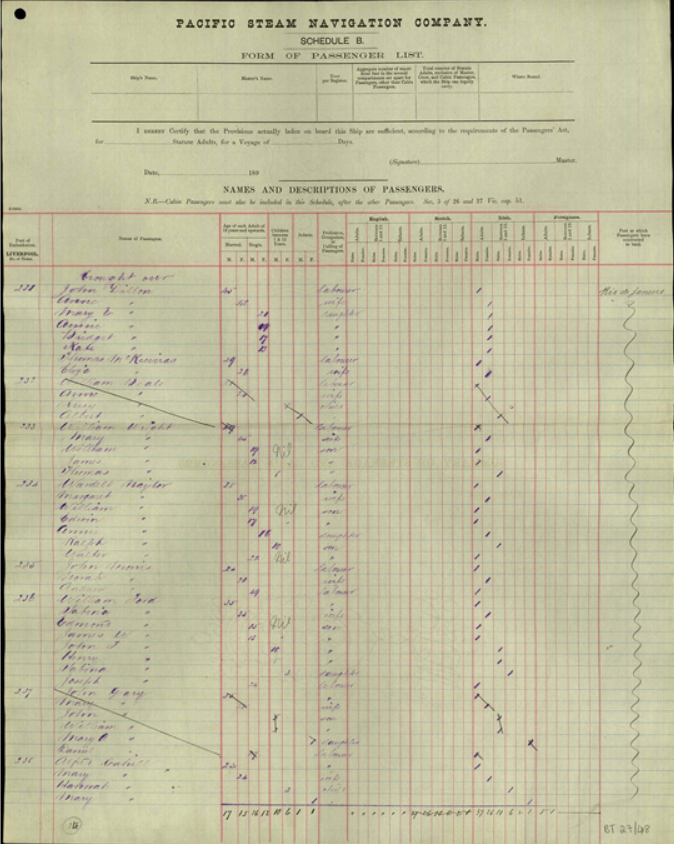
Boarding the Sorata for the journey was William age 49, Mary age 45, son William Jr age 19, James age 12 (age listed incorrectly, he was 10), and Thomas age 8 (he was 7).

Several lines down we find Norah at age 21 with her husband Hubert Morris age 2? (he is listed here as John — a nickname? middle name? maybe they just got it wrong?) and her father-in-law Andrew Morris age 49.


Photo of the Sorata, the ship the Wright family traveled on to Brazil, which was 401.3 ft long, 42.8 ft wide, and 34.1 ft deep.
What excitement and enthusiasm William and Mary, Norah and her family, and the children must have felt as they sailed out of port. For a family that had almost certainly never traveled outside of the immediate area surrounding Bradford, this must have been quite an adventure. Although I have never found a definitive reason, we can assume that the adults had found new, promising employment in Rio.
Sadly, the adventure had a tragic end.
Although we don’t have a death record, we know that William, Mary, and William Jr all died shortly after reaching Brazil, almost certainly of the Yellow Fever epidemic that gripped Brazil in 1891, beginning just about the time the family was arriving.

7 Mar 1891 from a U.S. newspaper.

25 May 1891 from a U.S. newspaper
On 15 Aug 1891, just 6 months after the family had left for Brazil, Norah returned to Southampton with her husband, father-in-law and two youngest brothers James and Thomas. They had left Brazil from the port of Santos, where the yellow fever was the worst.

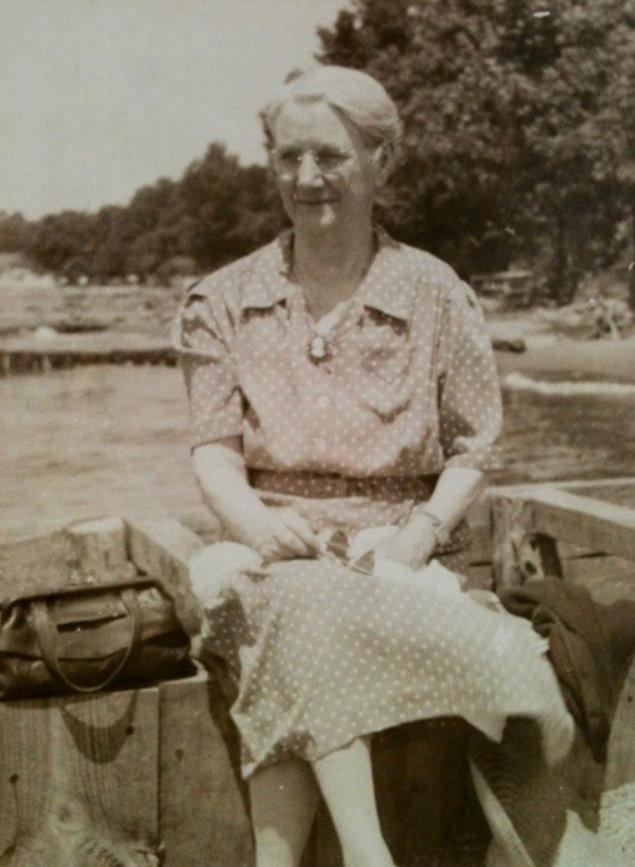
Honorah Wright Morris
How devastating this must have been! Norah, newly married and only 21 years old had lost her parents and brother and was now the guardian for her 10 and 7 year old brothers who had been orphaned. Norah was also 9 months pregnant with her first child at the time. William Morris, named for the father she had just lost, was born 11 days later on 26 Aug 1891. From what I have been able to determine, Norah raised both her brothers to adulthood. James married Mary Philip in 1907 and went on to have 3 children all raised in England. Thomas married in 1906 and immigrated to America in 1911/12 where his 4 surviving children were raised.
Norah deserves more mention as she was quite an impressive woman.
She and Hubert had 4 of their own children:
William Morris, 1891-1970
Cecilia Morris, 1894-1951
Honorah Morris, 1987-1978
Hubert Morris, 1905-1962
In 1912, with both of her brothers married and on their own, Norah and Hubert immigrated to America with the children and settled in Pennsylvania near her youngest brother Thomas and his family who immigrated at the same time. Unlike her aborted trip to Brazil, this time her adventure was a success. Her obituary, memorializing her death on 29 Oct 1946 tells a remarkable story about a woman who began life as a child working in the woolen mills in Bradford.
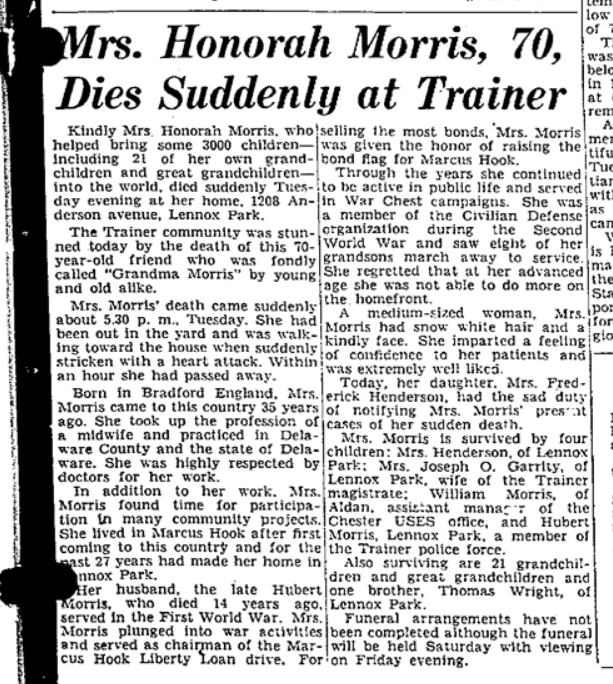
Generation 2: Thomas Wright (1884-1956) and Annie Thornton (1884-1967)
Jump to Generation: 7 | 6 | 5 | 4 | 3 | 2 | 1
Thomas Wright was born 12 Oct 1884 in Bradford, the fifth of 5 children born to William Wright and Mary Moran.

Like his older siblings, Thomas was destined for child labor working in the woolen mills that were the lifeblood of Bradford. But this was not to be. When he was just 7 years old, in 1891, his parents decided to seek a better life for their family, immigrating (whether the plan was temporary or permanent is unknown) to Rio de Janeiro, Brazil for work. Unfortunately, their timing was tragic as they arrived just as a devastating Yellow Fever outbreak started. Within the first six months or arriving, both of his parents and one of his older brothers had died. Thomas, at age 7, and his brother James, at age 10, were orphaned. Fortunately, his sister Norah who was 20/21 at the time had survived and returned to England with the boys and her husband.
It is believed that Norah and her husband Hubert Morris raised at least Thomas and probably James as well to adulthood, alongside their own 4 children. The 1901 Census finds Thomas in his sister’s household. At age 15 he was listed as a “jobber.” This is a term that meant he worked at odd jobs rather than full-time employment.

The next record is on 16 Apr 1906 when Thomas married Annie Thornton at Bradford Cathedral. Both of them were working in the mills when they married.


The interior of Bradford Cathedral where Thomas and Annie were married (By en:User:Soloist – en:wiki, CC BY-SA 3.0, https://commons.wikimedia.org/w/index.php?curid=4594516):
Annie Thornton was born 7 Feb 1884 in Bradford, the daughter of John H. Thornton (1845-1907) and Annie Eliza Appleby (1841-1929),also both from Bradford.

Thomas and Annie had 5 children together. The first 3 born in England:
Hubert Wright, 1907-1992
William Wright, 1910- sometime after 1940
Lucy Wright, 1911 died as an infant
The younger 2 born in America:
Anne Wright, 1915-1978
Thomas Christopher Wright, 1921-1990 (our ancestor)
Somewhere around 1909-1911, Thomas and Annie made the decision to immigrate to America. Perhaps the decision was made in conjunction with Norah (Thomas’ sister) and her husband Hubert who also immigrated at about the same time.
In the English 1911 Census, Annie and Norah were living together with their children in Bradford. Thomas and Hubert (Norah’s husband) were not living with them.

Presumably, Thomas and Hubert had come to America ahead of time. Their wives and children followed.
In 1911, Annie sailed out of Liverpool on the RMS Celtic with her three children to meet Thomas in America. She arrived at Ellis Island in August accompanied by two children. Sadly, it appears that her infant Lucy died during the crossing. Not long after, in 1912, Norah left for America with her children too, to join her husband Hubert.
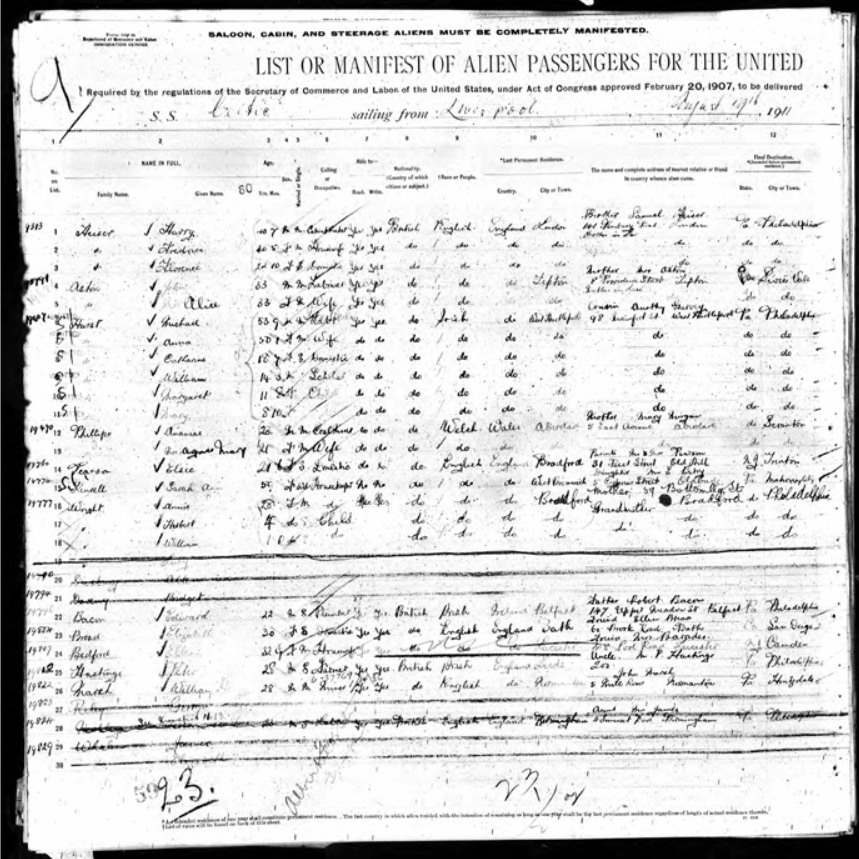
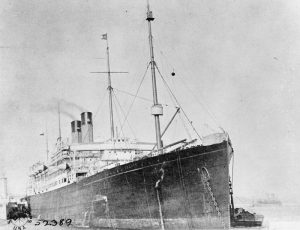
The RMS Celtic on which Annie and her children traveled to America
In 1918, from Thomas’ World War I Draft Registration, we know that he was working as a pipefitter in the Chester Ship Building in Chester, PA. He and Annie were living at 820 Church Street, Marcus Hook, PA. The home that is currently at that address was built in 1925, so the home Thomas and Annie lived in must have been torn down and rebuilt.
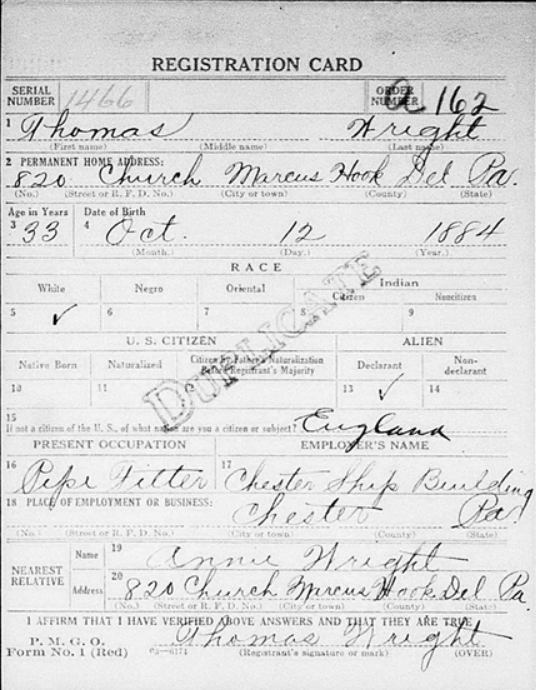
In the 1920 Census, Thomas and Annie were living in Pennsylvania, but now in Lower Chichester Township next door to Thomas’ oldest cousin William Morris (William had been named for Thomas’ deceased father William) and William’s family. Thomas was still working as a pipefitter.
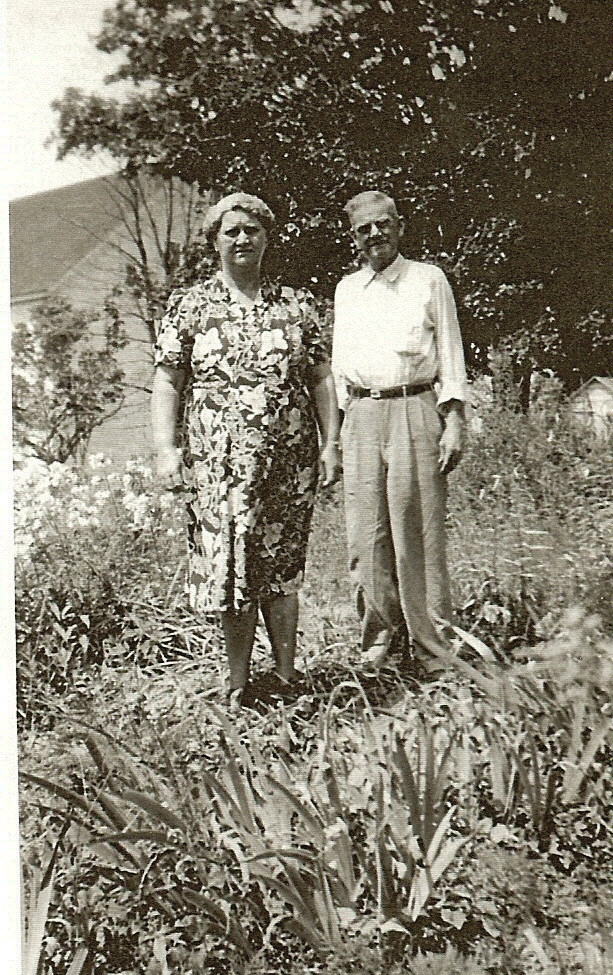
By 1930, Thomas was working as a spinner in a textile mill and owned a home valued at $4,000. Had he remained in Bradford, it seems unlikely he could have attained home ownership. Hubert and William, who were 23 and 20 respectively, were both working in an oil refinery. Anna and Thomas, at 15 and 9 were students. Had they remained in Bradford, both of them may have been working in the mills at this age. In 1940, Thomas and Annie were still living in the same home and were surrounded by family as neighbors: within a few doors lived Norah and Hubert Morris, also William Morris and his family and daughter Anna and her husband Matthew Mitchell.
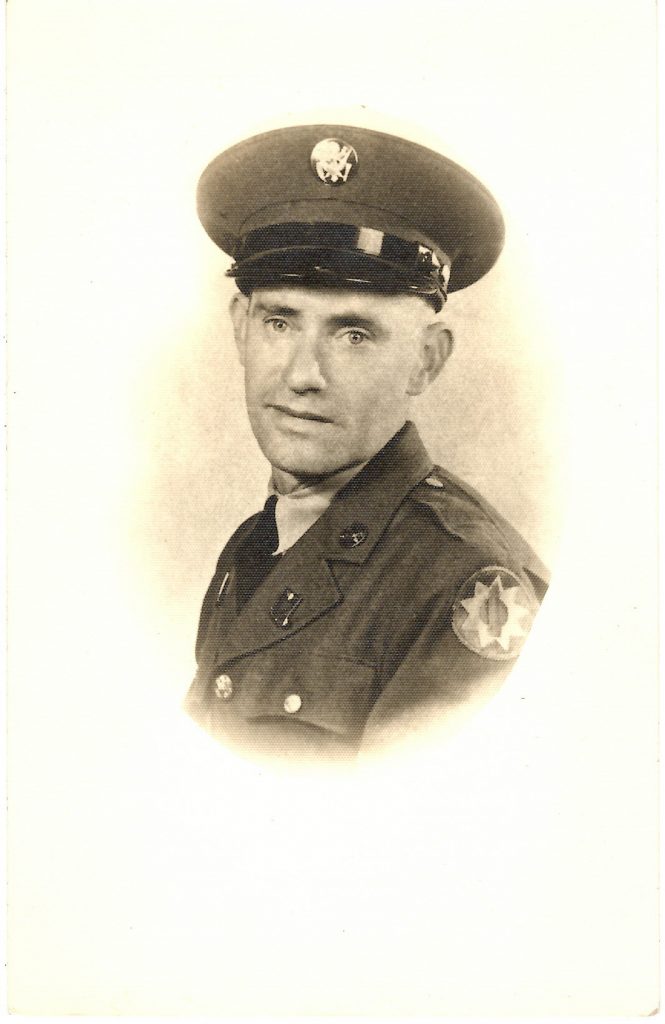
Hubert Wright 1942
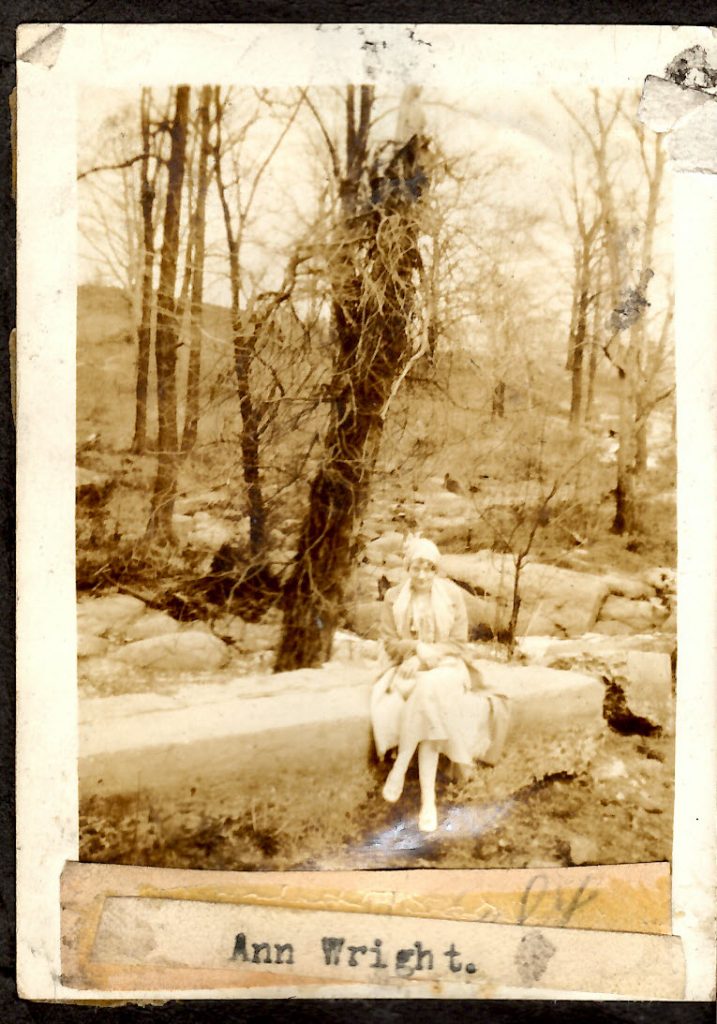 Forty years before, Thomas and Norah’s parents had brought their family to Brazil hoping for a better life, with the journey ending in tragedy. Finally it seems, Thomas and Annie and Norah and Hubert had achieved their parents dream in America.
Forty years before, Thomas and Norah’s parents had brought their family to Brazil hoping for a better life, with the journey ending in tragedy. Finally it seems, Thomas and Annie and Norah and Hubert had achieved their parents dream in America.
Thomas passed away 29 Apr 1956 at the age of 71. According to his death record, he died of cancer complicated by pneumonia.
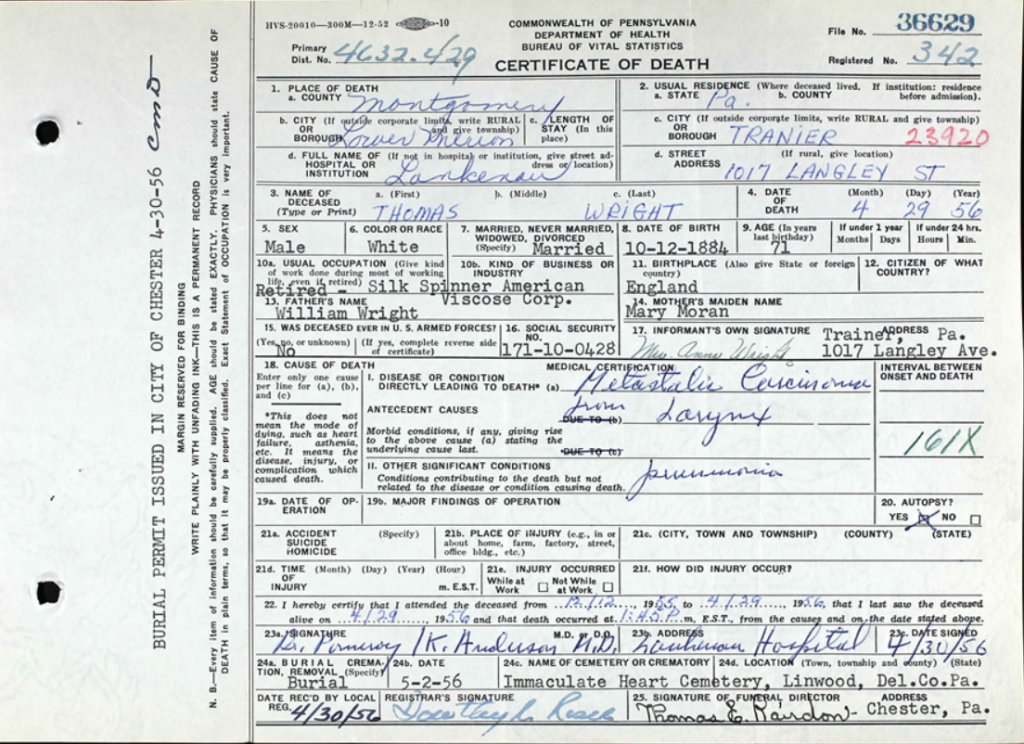
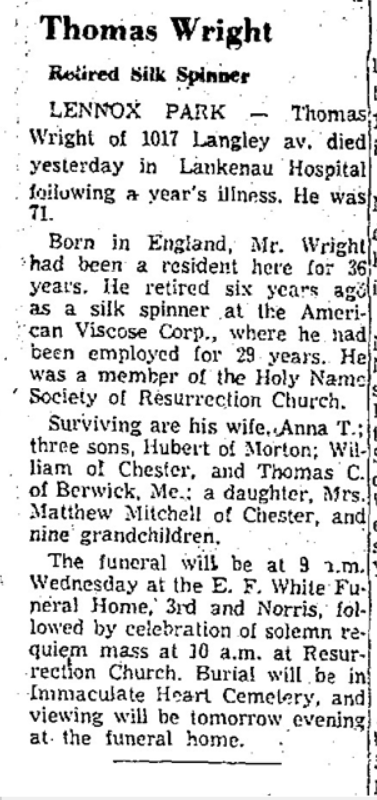
Annie lived for another 11 years and died in Dec 1967. She is buried with Thomas at the Immaculate Heart of Mary Catholic cemetery in Linwood, PA.

Generation 1: Thomas Wright (1921-1990) and Mary Louise McCarthy (1922-2013)
Jump to Generation: 7 | 6 | 5 | 4 | 3 | 2 | 1
I’ve written about my grandparents in another blog post that you can find here.
Thomas Christopher Wright was born 28 Jul 1921 in Chester, PA, the youngest of 5 children born to Thomas Wright and Annie Thornton—the second child born in America after his parents had immigrated from England.
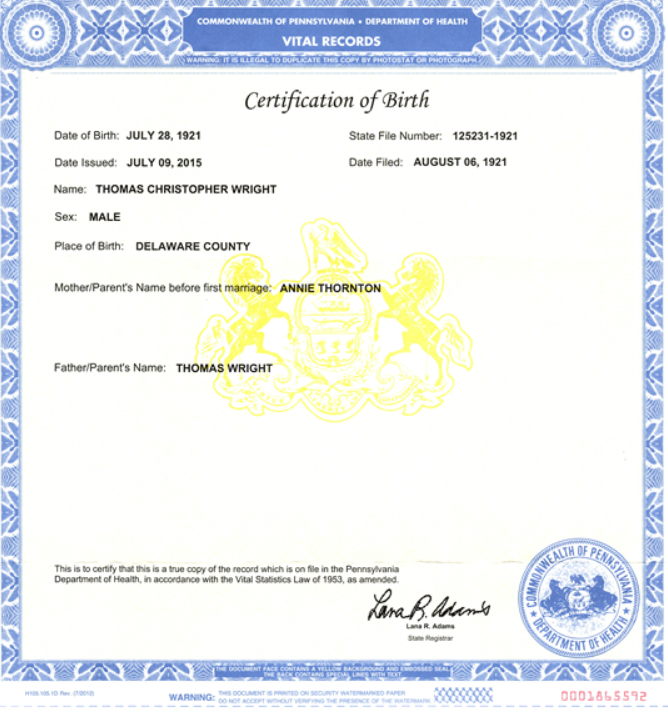
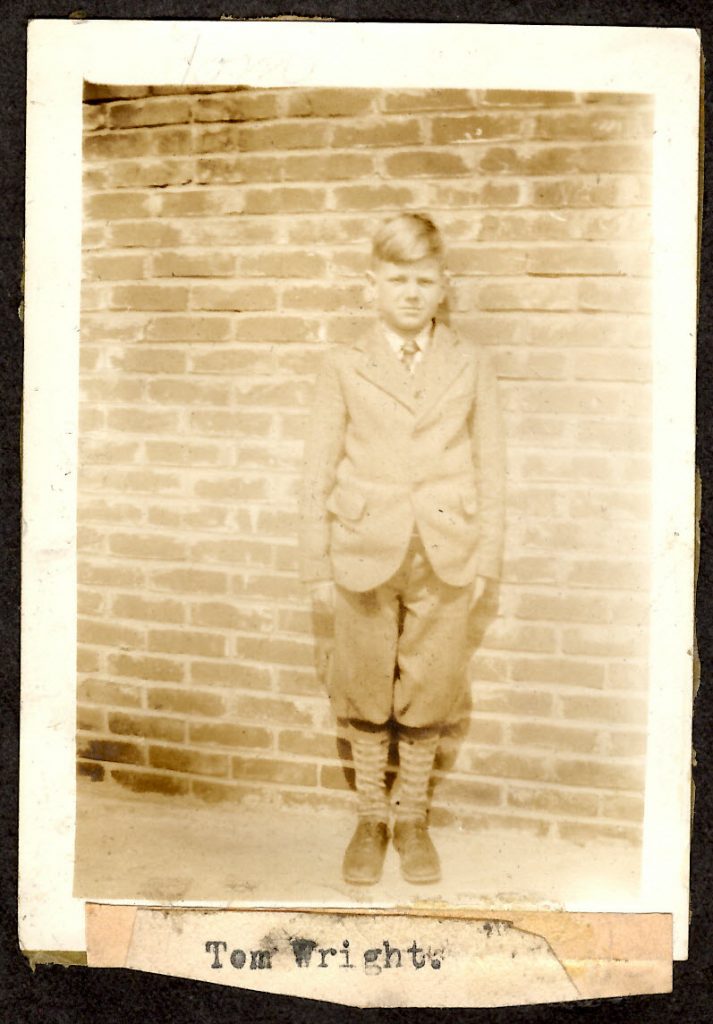
Thomas grew up in Trainer, PA and on 8 Dec, 1941, the day after the Japanese bombed Pearl Harbor, he went to the recruiting office and joined the Marines. Just a little over a month later, on 15 Jan 1942 he entered into service in the famed 1st Marine Division and was trained at Parris Island as a machine gunner.
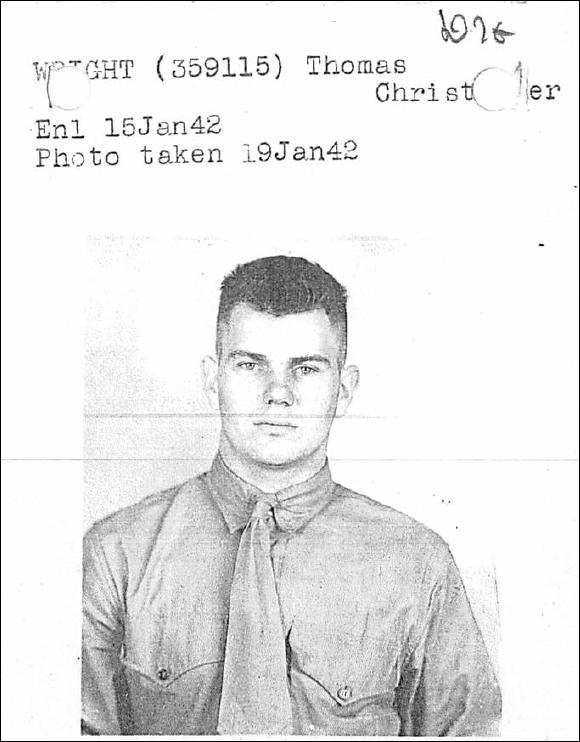
While in the Marines, Thomas became known by his fellow Marines as “Mike.” Apparently Thomas had a hard time remembering names and so always called everyone by the wrong name. As a joke, his friends began calling him by the wrong name also: Mike. And it stuck long after his discharge from the Marines. For the rest of Thomas’ life he went by the nickname “Mike.” (NOTE: Although this is the name I also knew my grandfather by, and it seems strange to call him Thomas, I will continue to refer to him as Thomas in the rest of this post, so as not to confuse the reader)
In the summer of 1942, Thomas’ troop was the third wave to hit the beach in Guadalcanal where he spent the next 5 months, manning a .30 caliber machine gun. This was his first battle action.
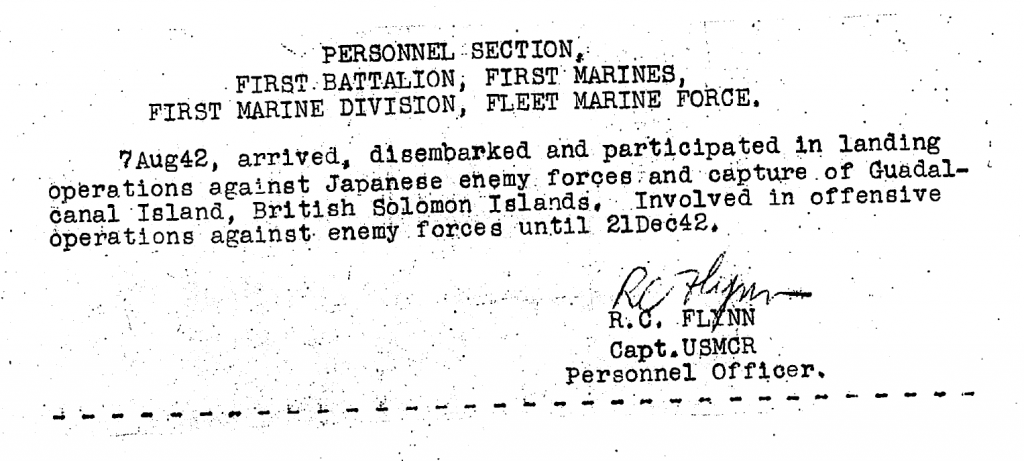
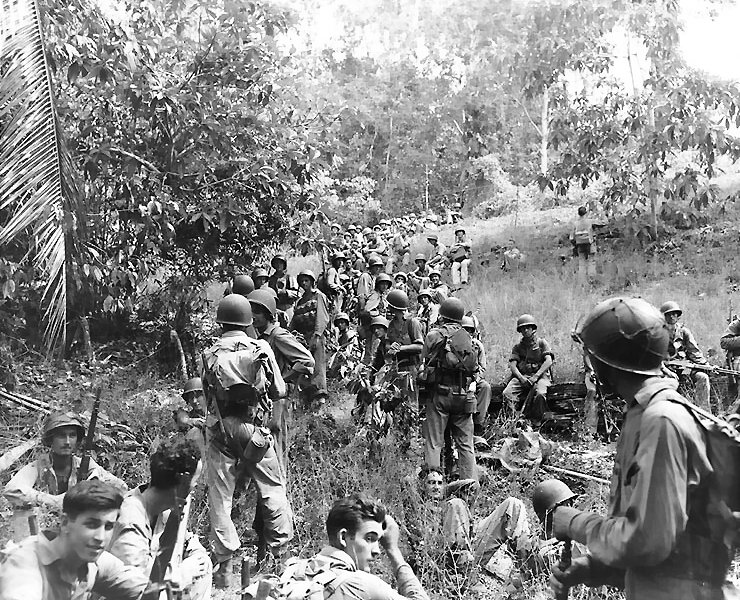
The 1st Marines resting in a field on Guadalcanal
Thomas’ personnel record but it doesn’t even come close to telling the story of what he must have been through. His record shows that he was engaged in battle in various ways for 28 days of those 5 months. It is hard to imagine.
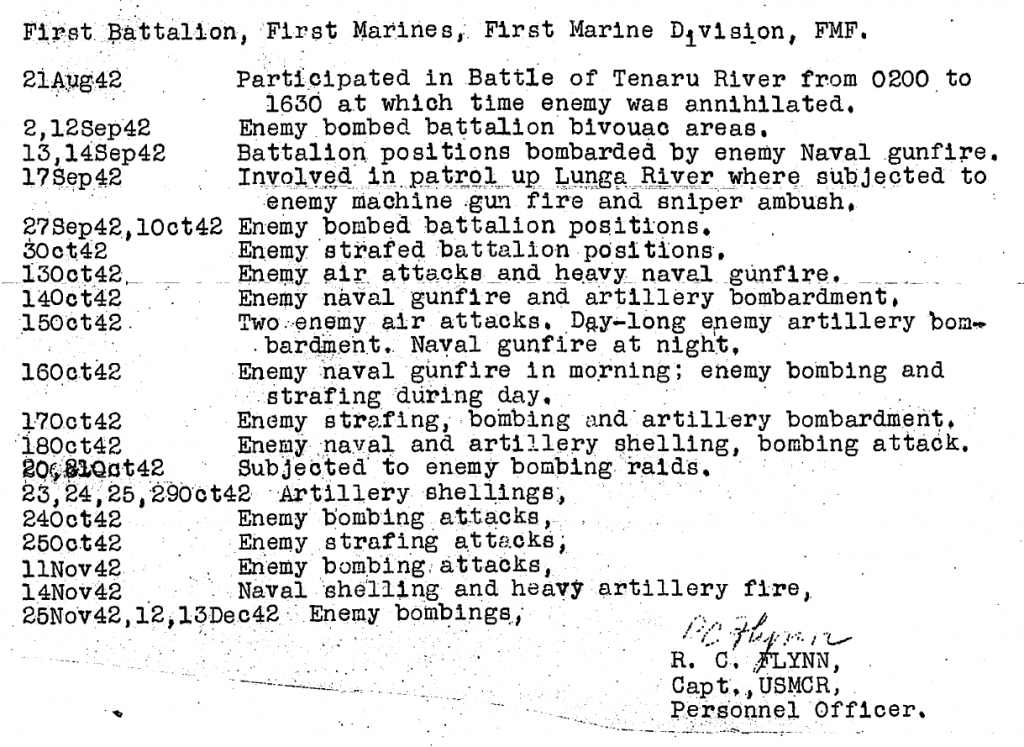
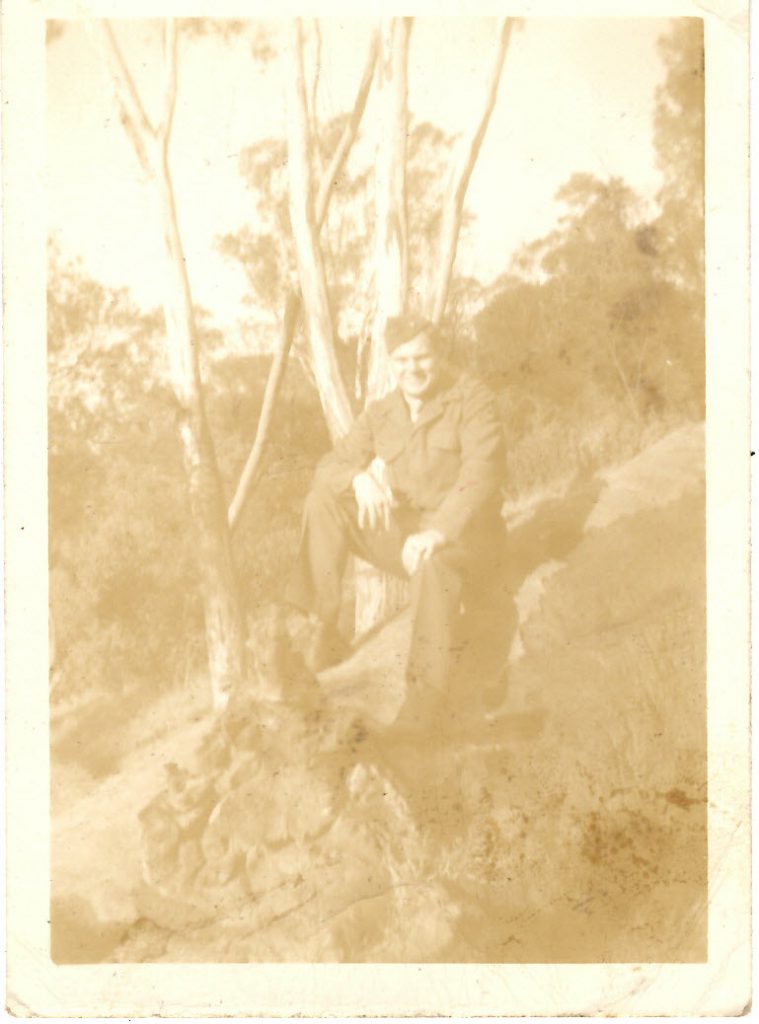
The $44/month that he earned for his service was sent home to his mother.
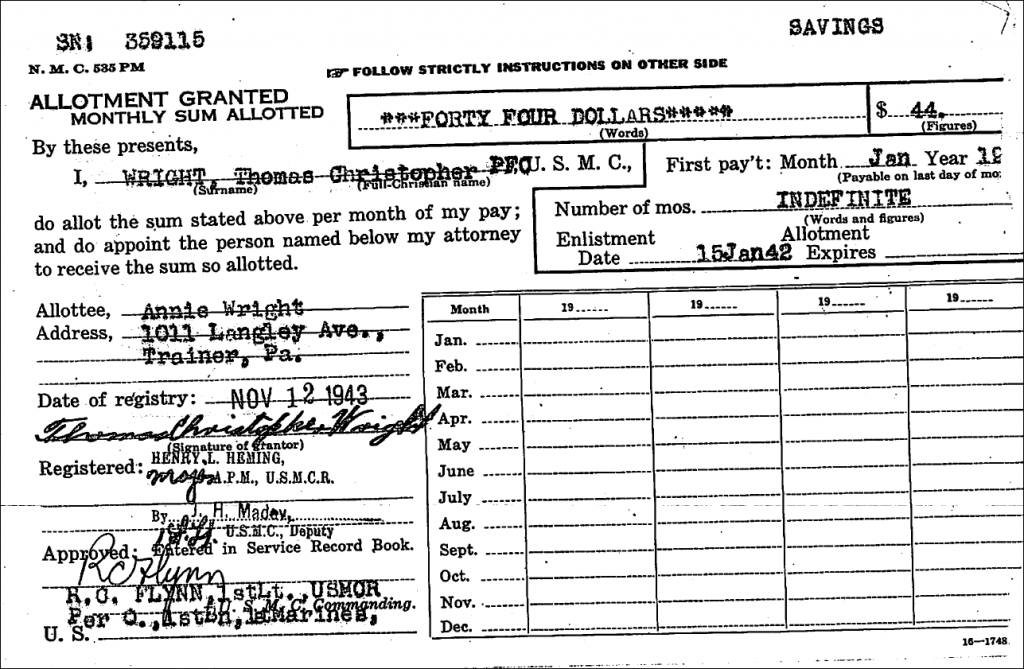
After Guadalcanal, which had been a grueling and exhausting experience for all, the 1st Marines were sent to Australia for 9 months of training and rest, but before the year was over, on the morning of 26 Dec 1943 they landed in Cape Gloucester where they remained for the next 4 months.
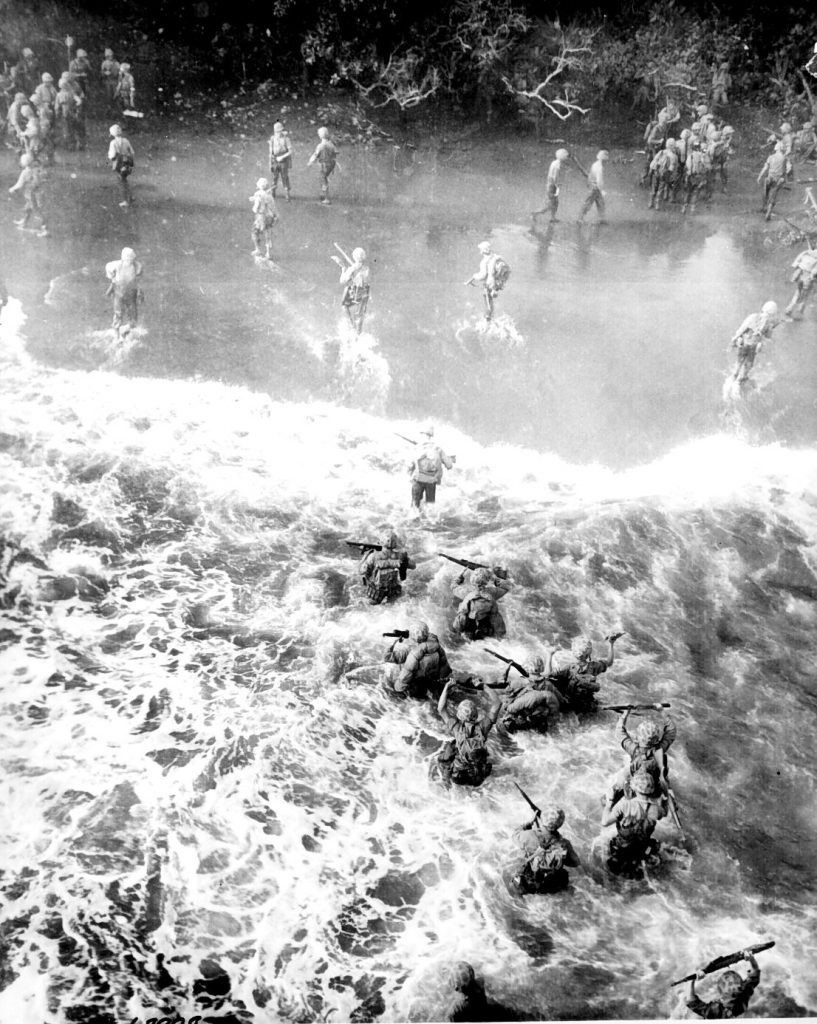
Marines wading ashore through rough water at Cape Gloucester
After a brief 4 month stay on Pavuvu Island, during which Thomas contracted and was treated for Malaria (he must have been quite sick as he used 23 days of sick time), he was sent on with his division to Peleliu Island where he disembarked 15 Sep 1944.
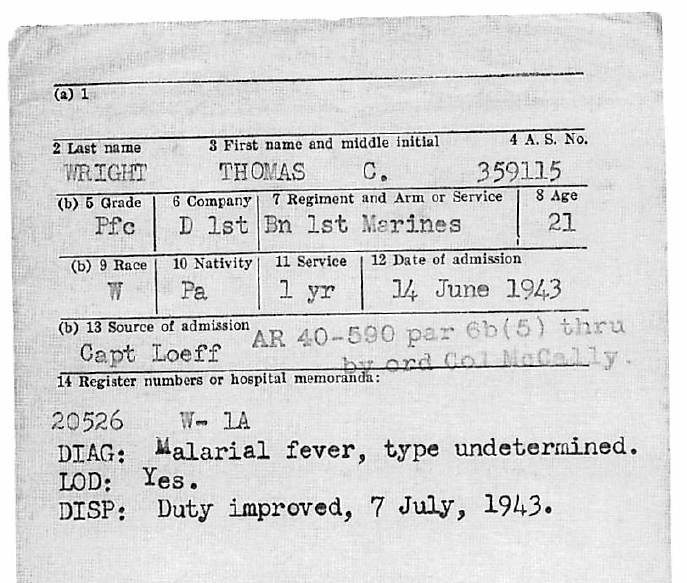

The Battle of Peleliu was known as one of the bloodiest in the Pacific, with the casualty rate the highest of all other land operations.
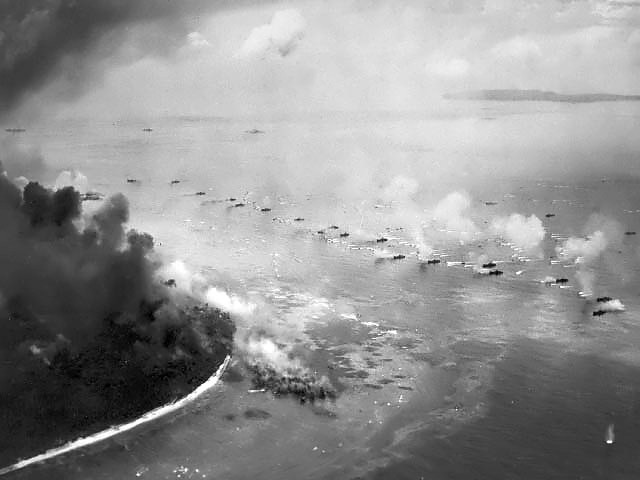
Photo of the first wave of Marines invading on 15 Sep 1944
This was the end of Thomas’ service. He later described it as the “worst action I ever saw.” Considering all the action he’d seen, that is an attention-getting statement. On 17 Sep 1944, a Japanese mortar round landed near his machine gun. One of his friends suffered a concussion, a second lost his arm, Thomas lost his eyes.
Having earned 2 Presidential Citations, the Purple Heart, and 6 major combat stars for his service, Thomas was flown back home to be treated in the Philadelphia Naval Hospital.

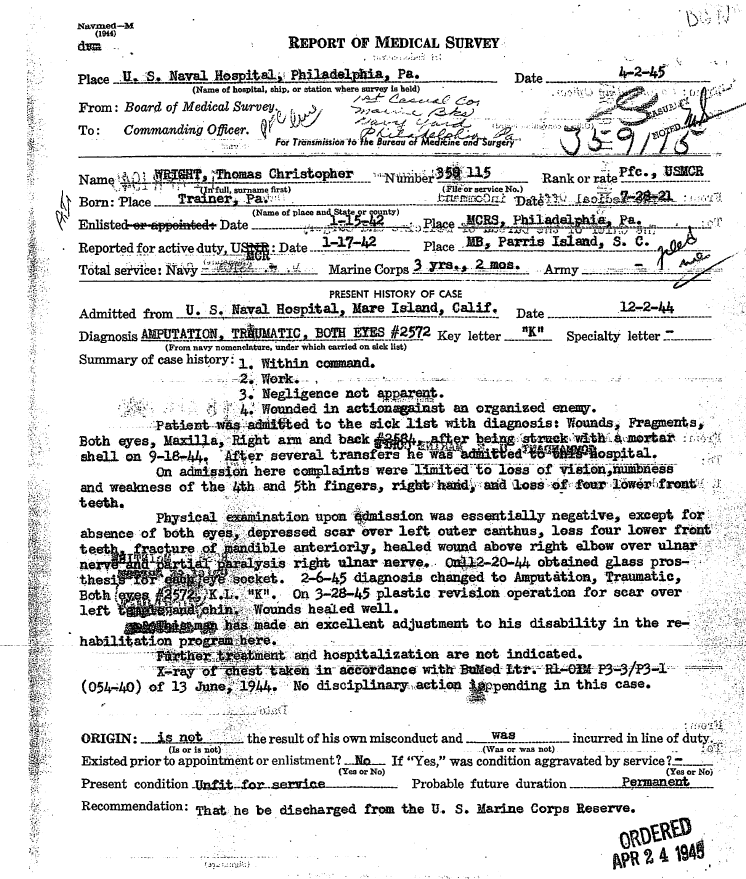
Thomas returned home a hero.

Article featured on the front page of the Chester Times 15 Dec 1944

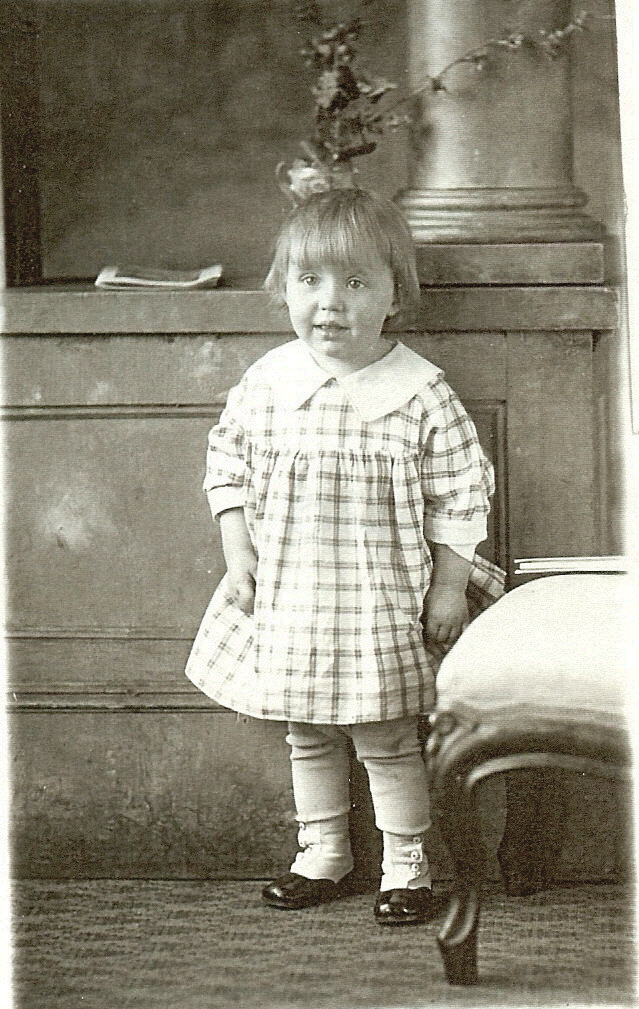
Mary Louise McCarthy – 1925
If you have read my other blog post, you know that this is when my grandparents met, fell in love, and married.
Mary Louise McCarthy was born 29 Apr 1922 in Lynn, MA, the second of 3 children born to Joseph McCarthy (1897-1966) and Verna Tucker (1896-1960). By the time she was 8 years old, her family had moved to Rochester, NH where the Tucker family had roots going back a number of generations.
Mary Louise was in the graduating class of 1940 at Spaulding High School in Rochester where she was the class Salutatorian and apparently quite active in school activities.

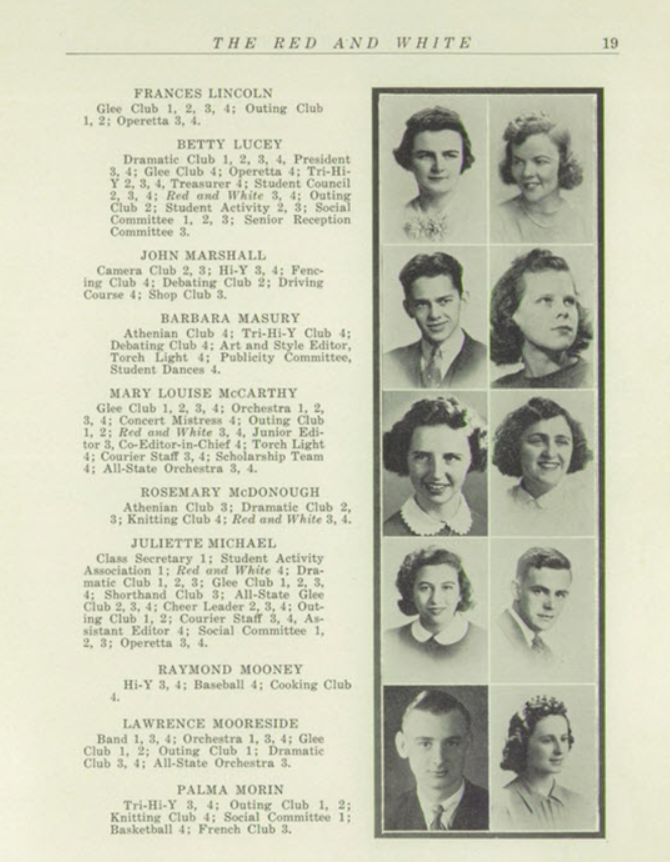
After high school, Mary Louise went on to earn a B.S. in Zoology from the University of New Hampshire, in an accelerated program that allowed her to graduate in 1943.
The spring before Thomas Wright was sent to Pelileu where he received the injuries that cut his military career short. Mary Louise was entering the WAVES. She trained in Boston and NYC as a Pharmacist’s Mate and was sent for service at the Philadelphia Naval Hospital.
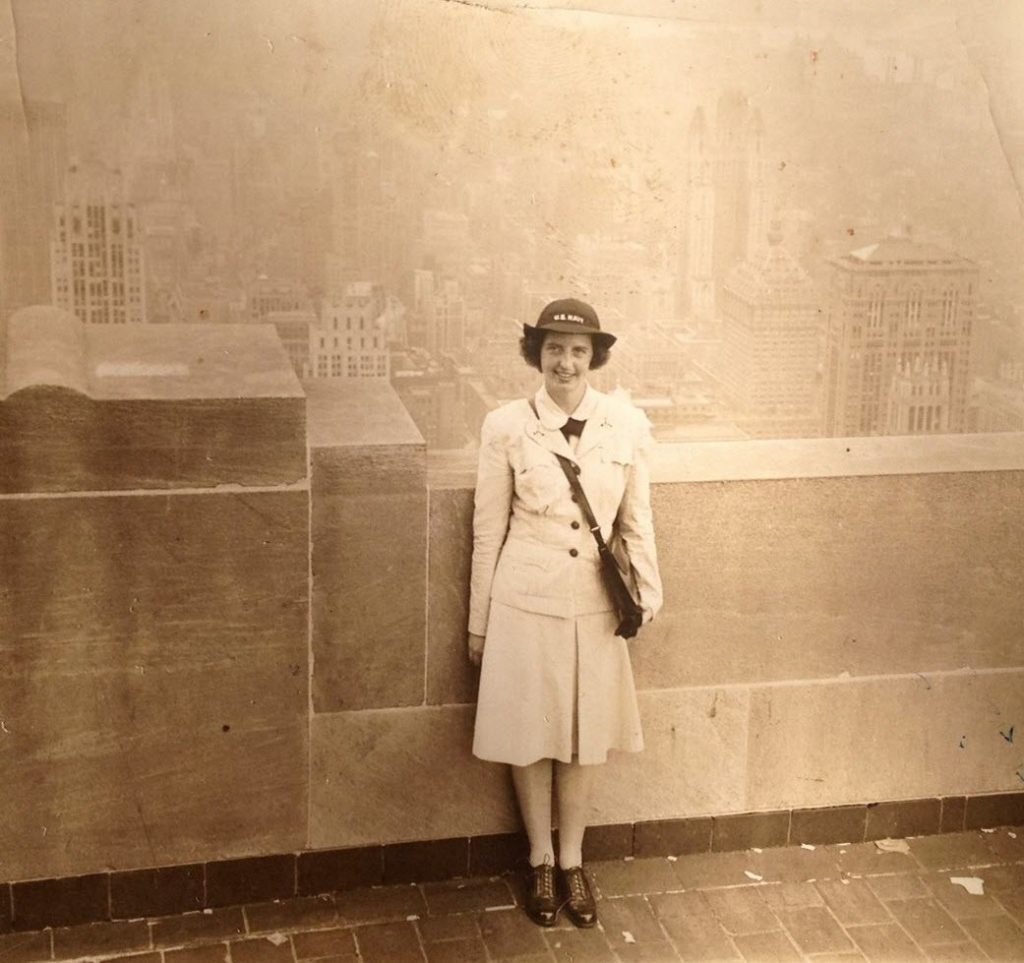
This is, of course, where she met Thomas who was one of her patients. Although, technically, he was not one of “her patients.” As the story was recounted by Mary Louise, they met because Thomas kept sneaking out of bed to visit one of his friends elsewhere in the hospital and she would repeatedly have to get him back to his own bed. This story makes me smile. Anyone who knew my grandparents and the way they interacted can likely imagine this scene vividly. By February of the following year, they were married.

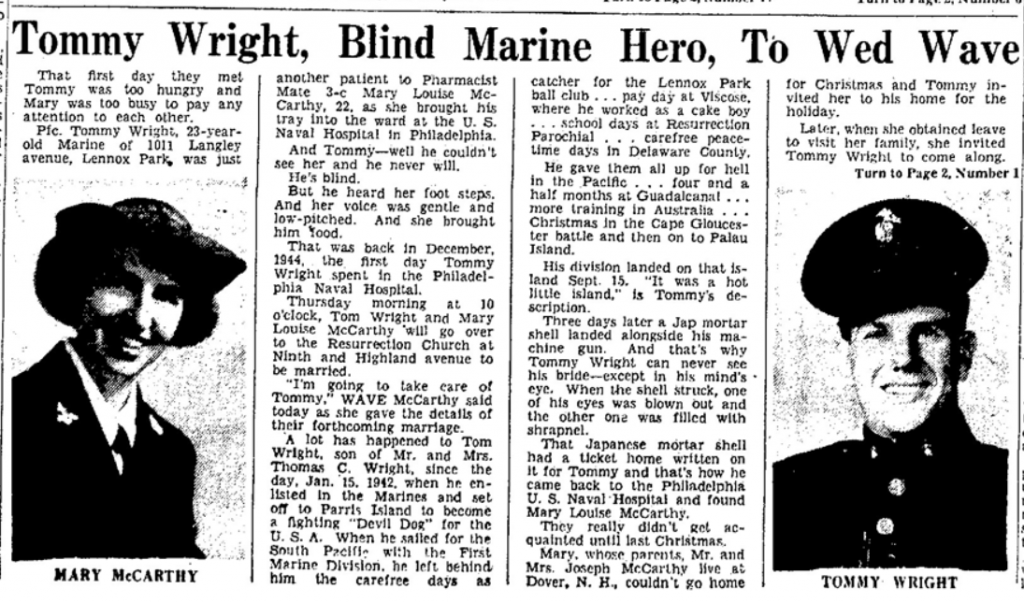

To read more about my grandparents and the amazing people they were and family they raised together, I hope you’ll read this other post I wrote and published last Memorial Day weekend.
Thomas Christopher Wright passed away on 25 Sep 1990 at the age of 69. Mary Louise McCarthy Wright outlived her husband by 23 years and passed away 10 Dec 2013 at the age of 91.
